Todd List was the guest speaker at the January 2011 Refresh Detroit Meeting. This was our third meeting covering Open Source Content Management Systems.
Todd List describes himself as “the geek who speaks people”. He definitely has a gift for describing complex tech subjects and simplifying them.
Todd kicked off the meeting by asking what types of websites the audience was interested in building. The range of responses was quite broad. Some wanted a site to promote a business or pastime including a clown, graphic design business, video production company, and a Segway rental business. Others wanted sites more to inform. These included sharing recipes, a video blog, and a blog to share pet stories. “All of these can be done with WordPress,” said Todd.
He included a humorous video create by Google in which people on a street in New York City were asked what they thought a web browser was. It was astonishing how few people could answer that question correctly. Todd used this to show that when building your site it’s important to keep things simple, clear and easy to use for your visitors.
He then explained what a blog and a CMS is. A blog is “just a web site that has content updated on a periodic basis, usually in a certain format.” Todd described a CMS, or Content management system as “a software package that allows a non-technical person to go in and make updates.”
“WordPress is a Content Management System. It started of with a very strong focus on blogs,” stated Todd. WordPress has the most market share of any of the opensource CMS today.
Todd then explained some important web terms using a clever comparison to a physical home. You’re site’s Domain Name is like your home’s street address. A site’s framework, whether a static web site or a site created with CMS software, is like your home’s foundation.
WordPress is free software in that its open source. “Anyone can download WordPress. You can use it for what ever you want. You are free to make modifications to it,” said Todd. “Its also free as in beer.” You aren’t charged money to use WordPress.
There are two flavors of WordPress — hosted and self-hosted. The hosted version at WordPress.com takes care of things like installation, maintenance and back-ups automatically for you. “It’s a great place to start.”, said Todd. The self-hosted version allows you more flexibility in themes and plug-ins. WordPress.com is basically free where with the self-hosted version you’ll have to pay a hosting company. There are actually more self-hosted installations than hosted.
Todd described how a static website works and how its different than the way WordPress works. He also explained how a WordPress theme controls the appearance and location of information on your site. WordPress plug-ins extend the functionality of WordPress.
Next, Todd gave the audience a demonstration of WordPress on his computer. He showed how it looks when it’s initially installed. He demonstrated how themes can be installed manually, which was the original way. In contrast he showed how they can now be installed easily without leaving the dashboard. While the themes are nice, you’ll often want customize them a bit. He suggested StudioPress as a source for themes that can be highly customized.
Some WordPress plug-ins do things that are obvious like adding a button or image to your site. Others work behind the scenes to do a variety of things like backing-up your site, tracking how your site is doing using Google Analytics, improving your site’s Search Engine Optimization.
He then briefly covered more advanced WordPress tools and technologies like WordPress MultiSite, BuddyPress, and bbPress.
“The beauty of WordPress is that it lets you manage your content very easily”, explained Todd. He demonstrated how simple it is to post a piece of new content. Using themes and plug-ins he showed how the content of the site can be quickly reorganized.
Todd spoke to the importance of planning your site before you begin building it. Installing WordPress without any plan is like “getting in a car, putting a key in the ignition, and stepping on the accelerator. Never mind that you didn’t back out of the driveway first!” A good place to start is to look at other websites and see how is the content is arranged. Think about what types of content your visitors expect to see.
Todd suggested resources for people who want to know more including:
• The books WordPress for Dummies and for more advanced users Digging Into WordPress
• The main WordPress.org site
• WordPress.tv
• www.wpbeginner.com
You can see the slides from Todd’s presentation at SlideShare.net.
Refresh would like to thank Todd for his excellent presentation. We’d also like to thank Mango Languages for hosting the meeting at their great headquarters in Farmington Hills, Michigan.
For more about Todd List visit: www.maxim650.com
For more about Mango Languages visit: www.mangolanguages.com

Whenever I tell clients that I’m going to build their website in WordPress, they look at me funny and tell me that they don’t want a “blog website”. After this I just refer them to my companies website, which is 100% WordPress and looks nothing like a blog, and they usually change their mind pretty quickly.
LikeLike
Thomas, your company’s site looks great! NeoInvoice looks very interesting also.
LikeLike